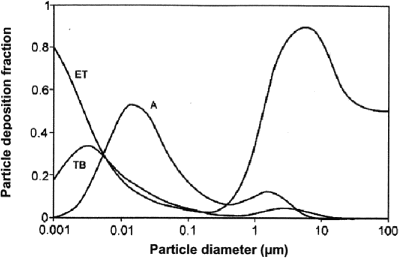Health effects assessment of exposure to particles from wood smoke
4 Toxicokinetics
4.1 Particle deposition in the respiratory tract
The deposition of inhaled particles depends on particle size, breathing pattern and lung structure (Sarangapani & Wexler 2000). Generally, as the particle size and breathing rate increases, particles deposit higher in the airways than at smaller size and slower breathing rates.
The respiratory tract of both humans and animals can be divided into three general regions on the basis of structure, size and function: the extrathoracic (mouth and throat), the trachea-bronchial and the alveolar regions.
In humans, inhalation can occur through the nose or mouth, while rodent animals, like the mouse, are obligatory nose breathers. Depending on the particle size and mass, varying degrees of deposition may occur in the extrathoracic, trachea-bronchial and alveolar region of the respiratory tract.
In general, particles larger than 4 µm and below 0.002 µm tend to deposit in the extrathoracic region, whereas particles in the fraction size 0.002 – 0.2 µm deposit in the alveolar region (Lippmann & Albert 1969, Stahlhofen et al. 1980); see also Figure 2.
Particle depositions differ among species due to differences in size, airway entrance and airflow (Lippmann & Schlesinger 1984). However, for particles smaller than 1 µm there are only minor differences between human and rat in the upper respiratory tract fractional deposition (Menache et al. 1995). The same pattern has been found for alveolar deposition of particles less than 0.1 µm (Schlesinger 1985).
4.2 Clearance and translocation
The term “clearance” is used to describe the translocation, transformation and removal of particles from the various regions of the respiratory tract. Clearance mechanisms may be broadly classified into two groupings, namely absorptive, which is dissolution, or non-absorptive, which involves mechanical transport of intact particles. Particle solubility in terms of clearance refers to solubility in vivo within the fluid lining the airway surfaces. Soluble particles are mainly cleared via absorption through cell surfaces into the blood stream (Schlesinger 2000). Insoluble material like wood combustion particles are cleared from the respiratory tract by the mechanisms described in the following. Unless anything else is stated, the text refers to Schlesinger (2000).
Particles larger than 10 µm are mainly deposited in the upper respiratory tract, from where they are removed by coughing, by expectoration or swallowed into the gastrointestinal tract. Relatively insoluble particles between 2.5 and 10 µm are mainly deposited in the ciliated regions of the tracheobronchial airways and are removed by the “mucociliary escalator” toward the epiglottis where they are removed in the same way as the larger particles (see above). This process is relatively effective with particles cleared within hours after exposure.
Figure 2. Particle deposition. Regional deposition of inhaled particles in the human respiratory tract. From The International Commission on Radiological Protection (ICRP 1994).

ET: Extrathoracic; TB: Trachea-bronchial; A: Alveolar
Clearance of insoluble particles deposited in the alveolar region is slower (weeks to years) and occurs via a number of mechanisms. The major pathway involves alveolar macrophages. These cells reside on the alveolar epithelium, and phagocytize and transport deposited material. The primary route for clearance of the particle-laden macrophages is via the mucociliary escalator. Macrophages, which are not cleared via the mucociliary system, may translocate to the interstitial tissue along with free particles. This transepithelial passage of free particles seems to increase as particle loading increases, and may be particle size dependent, since insoluble ultrafine particles show greater lymphatic uptake than do larger ones (Oberdörster et al. 1992). Particles and macrophages in the interstitium may enter the lymphatic system or traverse the alveolar-capillary endothelium, directly entering the blood. Passage through endothelial cells seems, however, to be restricted to particles <0.1 µm. Once in the systemic circulation, transmigrated macrophages, as well as free particles, can travel to extrapulmonary organs. Inhalation of 13C particles showed rapid clearance within hours upon inhalation and translocation of ultrafine particles via blood circulation to the liver (Oberdörster et al. 2002). Accordingly, it is important to consider extrapulmonary effects of inhaled particles.
The basic mechanisms of clearance of deposited particles from the respiratory tract are similar for humans and most other mammals. However, regional clearance rates show substantial variation between species, even for similar particles deposited under comparable exposure conditions (Snipes 1989).
Polycyclic aromatic hydrocarbons (PAHs) are carried along with soot particles to the lungs following inhalation exposure and the extent of their metabolic activation is therefore an important factor to consider. Recent results indicate that absorption through the alveolar epithelium is an important route of entry to the circulation of unmetabolised PAHs (Gerde et al. 2001). The authors investigated the rate and extent of release and metabolic fate of benzo[a]pyrene (BaP) adsorbed on a carbonaceous core of diesel soot after exposure of dogs by inhalation. Following deposition in the alveolar region a fraction of BaP was rapidly desorbed from the soot and quickly absorbed into the circulation. Release rates then decreased drastically. The rapidly released pulse of BaP appeared mostly un-metabolised in the circulation, along with low concentrations of phase I and phase II BaP metabolites. However, within about 1 hour, this rapidly absorbed fraction of BaP was systemically metabolised into mostly conjugated phase II metabolites.
Version 1.0 May 2008, © Danish Environmental Protection Agency